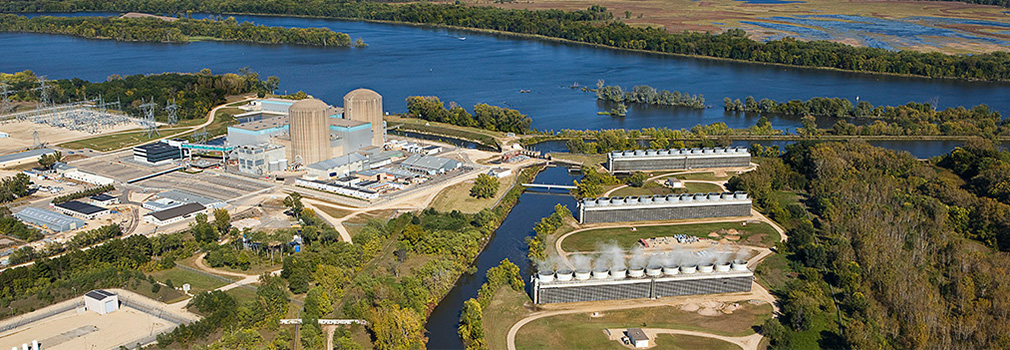Pioneering a bridge between nuclear and a hydrogen economy

A new frontier for nuclear energy in the United States is under exploration, and Xcel Energy is at the forefront with a project to produce hydrogen at its Prairie Island plant near Red Wing, Minnesota.
The company is working on an innovative pilot that will use the carbon-free electricity generated at the plant to produce hydrogen from water beginning in early 2024. The required engineering and equipment sourcing for the project is already under way.
“Our carbon-free nuclear fleet has been key to our energy system for decades,” said Pat Burke, vice president of Nuclear Strategy and Innovation. “This hydrogen project demonstrates our commitment to innovation and investing in new technologies.
“We’ve challenged our team to develop innovative ways to make our fleet even more valuable – and delivering carbon-free hydrogen shows they’ve answered that call,” he added. “This type of system could eventually be installed at nuclear plants around the country to produce a valued product used in a multitude of industries.”
Leading the way
The Prairie Island project is just one piece of a larger vision for hydrogen – itself one piece of Xcel Energy’s comprehensive clean energy transformation strategy. In 2018, the company became the first major utility to announce goals to reduce carbon emissions 80% by 2030 and reach 100% carbon-free electricity by 2050.
Hydrogen, Xcel Energy believes, has the potential to contribute substantially to that goal, as well as provide a low-carbon alternative to fossil natural gas in the coming decades. With an expanding renewable energy portfolio that already delivers record-setting clean energy, the company is challenging itself to achieve more while enhancing reliability and keeping customer bills low.
This includes industry partnerships to help develop new technology to achieve its goals. This is where Xcel Energy’s hydrogen effort comes in.
A $12 million U.S. Department of Energy (DOE) grant will help fund the pilot for a high-temperature steam electrolysis (HTSE) system that uses excess steam and electricity from its Prairie Island nuclear plant to power the process that splits hydrogen atoms from water. It would make Xcel Energy the first utility to use steam and electricity from a nuclear plant to make hydrogen via electrolysis. Using plant steam for the HTSE will be up to 30% more efficient than cold electrolysis.
A flexible and powerful resource
Hydrogen already is a key element in oil and chemical refining, as well as in the production of fertilizer in the form of ammonia. In the future, transportation could play a huge roll in hydrogen use – from long-haul semitrucks to ocean-going ships and even airliners.
In maritime use, for example, liquid ammonia could be converted to hydrogen to then feed fuel cells and power large vessels. And mixing hydrogen with carbon dioxide could eventually create a synthetic gas to replace many of current fuels, said Dan Ludwig, project lead and a senior engineer in Xcel Energy’s Nuclear Innovation Group.
“Replacing fossil fuels with zero-carbon fuels would be great from an infrastructure standpoint, as little might need to change,” Ludwig said. “The idea is to use carbon-free electricity to make carbon-free hydrogen to then make carbon-free ammonia and synthetic-gas, among other uses.”
Steel production is yet another possibility to meet hydrogen demand. Electricity and hydrogen can be used to make steel, instead of coal or natural gas.
“If we can make hydrogen, we’ll be able to use it in a lot of different ways,” he said. “And plenty of research is underway looking at just that."
Early action and partnerships
Xcel Energy, along with two other electric utilities, have joined with the DOE’s Idaho National Laboratory to conduct technical and economic research on ideas to expand the possibilities at current nuclear plants, beyond the production of electricity. For example, electrolysis can be reversed, possibly allowing hydrogen to serve as a type of battery. The company is also paving the way for future projects by navigating the web of government agencies and regulatory requirements involved.
With the modest growth of electric sales, now is a good time to look at hydrogen production and other ways nuclear plants can create new revenue, Ludwig said.
“In the future, instead of needing to curtail electric production at nuclear plants when demand is low and renewable generation is high, we can make hydrogen, store it and help decarbonize other industries, including our own,” he said.
The push toward electrification is likely to continue. But as the percentages of electrified products and industries grow, the task will become more difficult. And there will be industrial processes that can’t be electrified, where hydrogen could be a carbon-free saving grace, he said.
“Early efforts like this will position us to lead, be informed and make decisions, so when this technology moves forward, we’ll be ready,” Ludwig added. “And we need to keep our foot on the hydrogen gas pedal – so to speak – to help create the carbon-free future we’re planning for 2050, if not sooner.”


